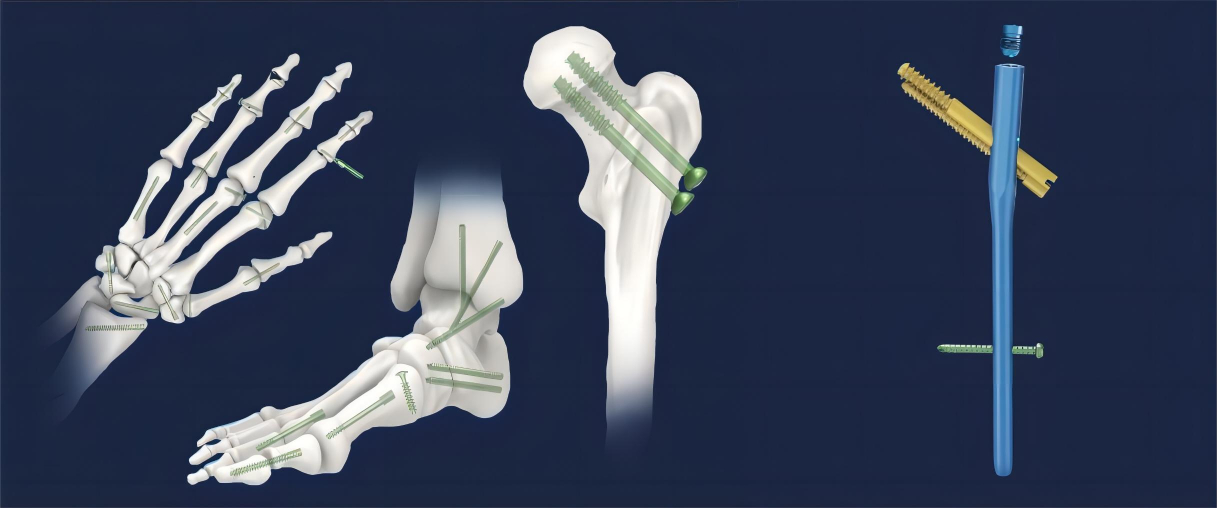Trauma Screws

bone screw
Internal fixation device for fixation of fracture sites. Use alone or in combination with plates. Cancellous bone screws, cortical bone screws, bone plugs and cannulated screws are commonly used.
Classification of Bone Screws
Classification according to application site (cortical bone screws, cancellous bone screws)
Classification according to characteristics (self-tapping screws, non-self-tapping screws)
Classification by screw design (e.g. cannulated, locking)
Classification by function or mechanism (plate screw, lag screw, position screw, interlocking screw, anchor, push-pull screw, reset screw, blocking screw)
1. Self-tapping screws (cancellous bone screws) are used for reduction and correction of fractures in the diaphysis of limbs, epiphysis, femoral neck, intertrochanteric, intercondylar, maxillofacial, metacarpal and foot fractures. The pitch is wider, the thread is thicker (stronger cutting force), the number of threads is less, the screw is thinner, and the guide hole (rotor head) is slightly thicker than the screw, which is convenient for the screw to cut and screw in by itself; it is mostly used for cancellous bone and is not suitable for Hard cortical bone, strong twisting force will break the screw; not suitable for use as a lag screw. As shown in Figure 1.
2. Non-self-tapping screws (cortical bone screws) have more threads and a narrower thread pitch; the thread of the matching tap is exactly the same as the screw thread, and it is sharper than the screw. Small size, high precision, repeated screwing in will not destroy the original thread, mostly used in cortical bone, poorer holding force than cancellous bone screws.
3. Lag screw. Also known as half-thread screw, its function is not specific to a certain type of screw, it can be a hollow screw or an ordinary screw. Femoral neck fractures are generally fixed with hollow screws, and at the same time, it is required to have tension and pressurize between the bone fragments. The most effective way is to use a lag screw. The direction of the lag screw is perpendicular to the fracture line, which can bring about the greatest interfragmentary compression. In most cases, the best function of the lag screw can be achieved. When the screw is not perpendicular to the fracture line, When tightened, shear forces are generated that displace the fractured fragments.
4. Cannulated compression screw. May itself function as a lag screw.
See the table below for details
|
name |
mechanism |
Application examples |
|
Plate screw |
Creates pressure and friction between the plate and the bone |
Forearm LC-DCP |
|
position screw |
Maintain anatomic alignment between bone fragments without compressing |
lower extremity tibiofibular screw |
|
interlocking nail |
For intramedullary nailing, maintaining bone length, alignment and rotation |
Femur/Tibia/Humerus Interlocking Intramedullary Nail |
|
Anchor |
As an anchor point for wire or strong suture |
Anchor for Medial Ankle Tension Band Fixation |
|
lag screw |
Compression between fractures with sliding holes |
Disc-shaped bone fragment, medial malleolus fracture |
|
push-pull screw |
As a temporary fixation point when reducing fractures with distraction/compression methods |
For pressurizers, spreaders |
|
reset screw |
Ordinary screws that pull the fracture fragment close to the plate through the hole of the plate, can be removed or replaced after the fracture is reduced |
Minimally invasive techniques should be used to reduce comminuted bone fragments to the LCP |
|
blocking nail |
Use the screw as a fulcrum to change the direction of the nail |
Intramedullary nailing for proximal tibial fractures |